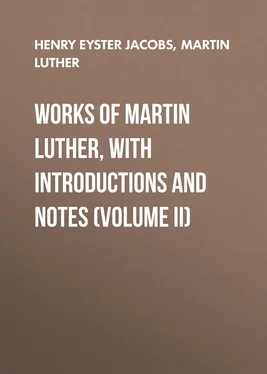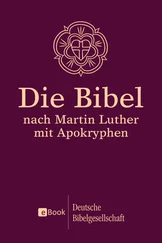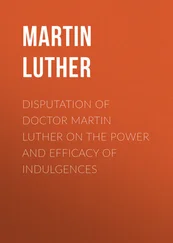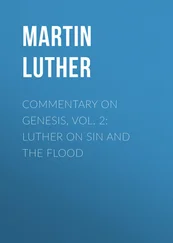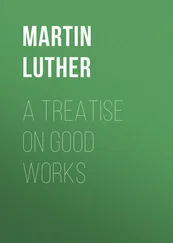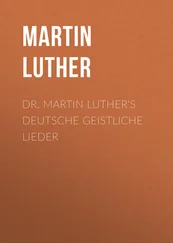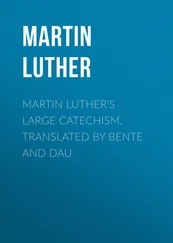See Vol. I, p. 56.
E. g., the danger of spilling the wine.
See p. 37. A TREATISE CONCERNING THE BAN 1520
Used here and above in the New Testament sense of true Christians, living or dead, cf. 1 Cor. 1:2.
See p. 11.
See above, pp. 12, 13, and Vol. I, pp. 59 ff.
The virgin Mary.
Cf. Enarratio in Ps. XXI (Migne, xxxvi, 178).
Penitential works.
Cf. Acts 2:46.
See Vol. I, p. 310.
In the Vulgate the Greek word "mystery" is translated by sacramentum . See below, p. 258.
Luther still adheres to the doctrine of transubstantiation. But see below, pp. 187 ff.
See p. 11.
Cf. below, p. 192.
See Luther's explanation of the First Commandment in the Catechisms. Also the answer to the last question in Part V, Small Catechism.
Treatise on Penance ( Weimer Ed. , II, 721), where Luther exhorts the troubled conscience to pray with the father of the lunatic boy, "Lord, I believe, help Thou mine unbelief," and with the Apostles, "Lord, increase our faith."
Cf. above, p. 17.
The Church.
A transubstantiation in the communicant.
A work that is done without reference to the doer of it.
A work considered with reference to the doer of it.
An opus operatum .
An opus operantis .
Cf. 1 Cor. 11:30.
Sodalities; see Introduction, p. 8, and below, pp. 137 f.
On festival days of the order and on saints' days.
The Carmelites are supposed to have been the first to organize sodalities, having organized in the fourteenth century the Sodality of Our Lady of Carmel. St. Anne was the mother of the Holy Virgin. Her sodalities were, as Kolde says, epidemic in 1520. Luther's appeal to St. Anne in the thunderstorm is well known (Comp. Köstlin-Kawerau, I, 55). There was a sodality of St. Anne, besides one of St. Augustine and one of St. Catherine, in the monastery at Erfurt in Luther's day. St. Sebastian was a martyr of the fourteenth century. His day is January 20. Comp. Arts. Anna , Sebastian and Bruderschaten in Prot. Realencyk ., I, SS2; II, 534 l.
A trades' guild brotherhood.
Douay Version, based on Vulgate, from which Luther quotes.
See above, p. 10.
I. e., in marriage.
See below, p. 37.
See below, p. 50.
See below, p. 51.
See Enders, I, No. 84. Smith. Luther's Correspondence , I, No. 69.
See Enders, I, No. 90. Smith, Luther's Correspondence , I, No. 77.
In the preceding treatise on the Blessed Sacrament .
See above, p. 10.
See above, p. 18.
I. e., the necessaries of life.
E. g., the crusades against heretics, and the inquisition of the thirteenth century. Luther's statement that to burn heretics is contrary to the will of the Holy Spirit was condemned in the Bull Exsurge Domine , of July 15, 1520.
Cf. p. 53.
Cf. p. 10.
See Vol. I, pp. 53, 163 ff.
The officials were officers of the bishops' courts; see also below, p. 103.
In Vito, lib. V, tit. xi, c. I, Cum medicinalis .
According to Luther's interpretation of 1 Cor. 5:5. Cf. also Acts 5:5.
The passage quoted from the canon law.
For instances see the Gravamina of the German Nation (1521), Wrede, Deutsche Reichstagsakten , II, 685.
Thiele, Luthers Sprichwörtersammlung , No. 276.
I. e., a cleric.
This statement also was condemned in the papal bull.
The "officials" were the administrators of this discipline, see above, p. 41.
A very important limitation for Luther's position.
See Open Letter to the Nobility, below, p. 98.
Again an important limitation.
See above, p. 41.
The ashes of Hus were cast into the Rhine (1415), and the body of Wycliff was exhumed and cremated and the ashes cast into the water (1427).
See above, p. 42.
In 1518 both George and Frederick of Saxony took the position that spiritual jurisdiction should be limited to spiritual matters. Gess, Akten und Briefe zur Kirchen politik Georgs 1, 44.
Luther puts a peculiar construction upon this passage.
The ancient service was divided into the service of the Word ( missa catechumenorum ) and the celebration of the sacrament ( missa fidelium ); before the second, those under the ban as well as the catechumens were required to withdraw.
The "great ban" excluded from all services.
According to Roman Catholic usage there is a distinction between hearing mass and receiving the sacrament.
Compare Treatise Concerning the Blessed Sacrament, above, p. 25.
In this edition, I, 337 ff.
Enders, II, 414; Smith, L.'s Correspondence , I, No. 266.
Enders, II, 424.
See below, p. 62.
See letter of June 7th to John Hess, Enders, II, 411; Smith, I, No. 265.
Published at Rome 1519; printed with Luther's preface and notes, Weimar Ed., VI, 328ff.; Erl. Ed., op. var. arg., II, 79 ff.
Weimar Ed. , VI, 329.
See Enders, II, 415, 443; Smith, Nos. 269, 279, and documents in St. Louis Ed. , XV, 1630 ff.
See Köstlin-Kawerau, Martin Luther , I, 308 ff., and Weimar Ed. , VI, 381 ff.
See Luther's letters to Lang and Staupitz, who wished to have the publication withheld (Enders, II, 461, 463).
Читать дальше
